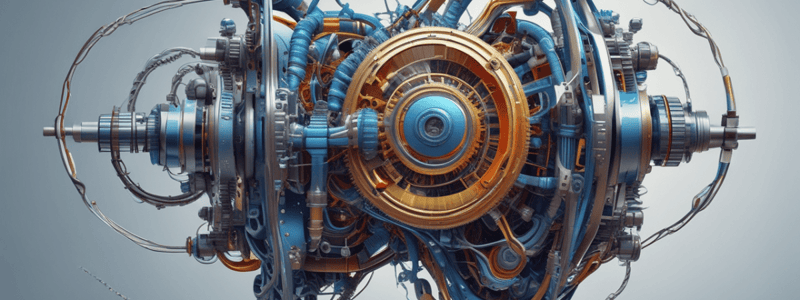Podcast
Questions and Answers
Internal forces in the musculoskeletal system are produced by structures located outside the body.
Internal forces in the musculoskeletal system are produced by structures located outside the body.
False (B)
Passive forces in the musculoskeletal system are typically generated by tension in stretched periarticular connective tissues.
Passive forces in the musculoskeletal system are typically generated by tension in stretched periarticular connective tissues.
True (A)
External forces acting on the musculoskeletal system are mainly due to the force of attraction between two objects.
External forces acting on the musculoskeletal system are mainly due to the force of attraction between two objects.
False (B)
Sir Isaac Newton's observations in the 17th century laid the foundation for understanding human movement analysis.
Sir Isaac Newton's observations in the 17th century laid the foundation for understanding human movement analysis.
Newton's laws of motion include the Law of inertia, Law of acceleration, and Law of resistance.
Newton's laws of motion include the Law of inertia, Law of acceleration, and Law of resistance.
Active forces in the musculoskeletal system are generally produced involuntarily.
Active forces in the musculoskeletal system are generally produced involuntarily.
The outcome of all movement analysis is solely determined by external forces acting on the body being moved.
The outcome of all movement analysis is solely determined by external forces acting on the body being moved.
Newton's principles of mechanics are not relevant to human movement analysis.
Newton's principles of mechanics are not relevant to human movement analysis.
Forces are scalar quantities.
Forces are scalar quantities.
Internal forces include gravity.
Internal forces include gravity.
The center of gravity (CoG) of the body is always at the second sacral vertebra (S2).
The center of gravity (CoG) of the body is always at the second sacral vertebra (S2).
To be stable, the line of gravity (LoG) must fall outside the base of support.
To be stable, the line of gravity (LoG) must fall outside the base of support.
The larger the base of support, the lower the stability of an object.
The larger the base of support, the lower the stability of an object.
The closer the center of gravity is to the base of support, the less stable the object is.
The closer the center of gravity is to the base of support, the less stable the object is.
Internal forces include muscle.
Internal forces include muscle.
The action line of gravity (LoG) is oriented vertically downward toward the moon.
The action line of gravity (LoG) is oriented vertically downward toward the moon.
The mass moment of inertia depends only on the mass of the body.
The mass moment of inertia depends only on the mass of the body.
Linear acceleration is directly proportional to the mass of the body.
Linear acceleration is directly proportional to the mass of the body.
The formula for rotational movement is α = M/I.
The formula for rotational movement is α = M/I.
If the sum of forces acting on a body is zero, acceleration is also zero.
If the sum of forces acting on a body is zero, acceleration is also zero.
A body will accelerate in the opposite direction of the resultant force.
A body will accelerate in the opposite direction of the resultant force.
Linear acceleration is directly proportional to the force causing it.
Linear acceleration is directly proportional to the force causing it.
Angular acceleration is inversely proportional to mass moment of inertia.
Angular acceleration is inversely proportional to mass moment of inertia.
Torque acceleration relationship formula is M = I * α.
Torque acceleration relationship formula is M = I * α.
The upper trapezius and serratus anterior are muscles that work together to produce a moment.
The upper trapezius and serratus anterior are muscles that work together to produce a moment.
The situation where two muscles with different magnitudes and orientations work together is referred to as a force couple.
The situation where two muscles with different magnitudes and orientations work together is referred to as a force couple.
Kinetic friction is always greater than static friction.
Kinetic friction is always greater than static friction.
Frictional forces can only resist the movement of an object when it is at rest, not when it is in motion.
Frictional forces can only resist the movement of an object when it is at rest, not when it is in motion.
Increasing the perpendicular forces pressing two objects together can decrease static friction.
Increasing the perpendicular forces pressing two objects together can decrease static friction.
To initiate dragging an object across a surface, it takes less force than to continue dragging it.
To initiate dragging an object across a surface, it takes less force than to continue dragging it.
Friction resistance only occurs between two contacting surfaces.
Friction resistance only occurs between two contacting surfaces.
A force couple refers to the situation where two muscles have identical magnitudes and orientations.
A force couple refers to the situation where two muscles have identical magnitudes and orientations.
A second-class lever is common in the musculoskeletal system.
A second-class lever is common in the musculoskeletal system.
The calf muscles act as the external force in a second-class lever.
The calf muscles act as the external force in a second-class lever.
In a third-class lever, the muscle force always has greater leverage than the external weight.
In a third-class lever, the muscle force always has greater leverage than the external weight.
Third-class levers provide more stability compared to second-class levers.
Third-class levers provide more stability compared to second-class levers.
Vector resolution is about breaking multiple forces into a single force.
Vector resolution is about breaking multiple forces into a single force.
The axis of rotation in a third-class lever is located at one end of a bone.
The axis of rotation in a third-class lever is located at one end of a bone.
The internal and external forces in a system always act in opposite linear directions.
The internal and external forces in a system always act in opposite linear directions.
Musculoskeletal levers are commonly used to rapidly accelerate objects in smaller ranges of motion.
Musculoskeletal levers are commonly used to rapidly accelerate objects in smaller ranges of motion.
Flashcards are hidden until you start studying
Study Notes
Types of Forces
- External forces arise from outside the body, including gravity and periodic forces
- Internal forces arise from inside the body, including active forces generated by muscles and passive forces generated by connective tissues
Forces as Vector Quantities
- Forces are defined by:
- Point of application: where the force acts on the object
- Action line and direction: the direction of the force
- Magnitude: the amount of force being exerted
Force of Gravity
- The center of gravity (CoG) of the body lies approximately anterior to the second sacral vertebra (S2)
- Each segment of the body has its own CoG and is acted on by the force of gravity
- The action line of gravity (LoG) is always vertically downward towards the center of the earth
Stability and the CoG
- To be stable, the LoG must fall within the base of support
- When the LoG falls outside the base of support, the body will tend to fall
- The larger the base of support, the greater the stability
- The closer the CoG is to the base of support, the more stable the object
Biomechanical Principles
- Newton's laws: Law of Inertia, Law of Acceleration, and Law of Action-Reaction
- Newton's second law: F = m * a (linear acceleration) and M = I * α (angular acceleration)
Analysis of Forces
- Internal forces (Fi) include active forces generated by muscles and passive forces generated by connective tissues
- External forces (Fe) include gravity, weights, and physical contact
- Forces can be analyzed using Newton's laws and principles
Friction
- Friction is the resistance to movement between two contacting surfaces
- Static friction is greater than kinetic friction
- Friction can be increased by increasing the normal or perpendicular forces pressing the two objects together
Musculoskeletal Levers
- Second-class lever: has a fulcrum at one end of a bone, and the internal force has greater leverage than the external force
- Third-class lever: has a fulcrum at one end of a bone, and the external force has greater leverage than the internal force
- Musculoskeletal levers can be used to accelerate objects in different ranges of motion (ROM) and have varying stability effects
Studying That Suits You
Use AI to generate personalized quizzes and flashcards to suit your learning preferences.




